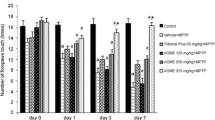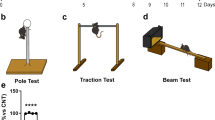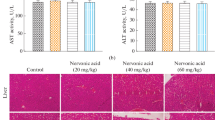Abstract
Parkinson’s disease (PD) is an incurable neurodegenerative disease characterized by motor and non-motor disabilities resulting from neuronal cell death in the substantia nigra and striatum. Microglial activation and oxidative stress are two of the primary mechanisms driving that neuronal death. Here, we evaluated the effects of geranium oil on 1-methyl-4-phenyl-1,2,3,6-tetra-hydropyridine (MPTP) mouse model for PD, on microglial activation, and oxidative stress. We demonstrate that oral treatment with geranium oil improved motor performance in this model. The therapeutic effects of geranium oil were observed as a significant increase in rotarod latency and distance among the mice treated with geranium oil, as compared to vehicle-treated MPTP mice. Geranium oil also prevented dopaminergic neuron death in the substantia nigra of the treated mice. These therapeutic effects can be partially attributed to the antioxidant and anti-inflammatory properties of geranium oil, which were observed as attenuated accumulation of reactive oxygen species and inhibition of the secretion of proinflammatory cytokines from geranium oil-treated activated microglial cells. A repeated-dose oral toxicity study showed that geranium oil is not toxic to mice. In light of that finding and since geranium oil is defined by the FDA as generally recognized as safe (GRAS), we do not foresee any toxicity problems in the future and suggest that geranium oil may be a safe and effective oral treatment for PD. Since the MPTP model is only one of the preclinical models for PD, further studies are needed to confirm that geranium oil can be used to prevent or treat PD.






Similar content being viewed by others
Data Availability
Data will be made available upon request.
Abbreviations
- ABAP:
-
2,2’-azobis(amidinopropane)
- DAT:
-
Dopamine transporter
- DCF-DA:
-
2’7’-dichlorofluorescein diacetate
- IL-1β:
-
Interleukin 1β
- IL-6:
-
Interleukin 6
- GC-MS:
-
Gas chromatography-mass spectrometry
- GRAS:
-
Generally recognized as safe
- LPS:
-
Lipopolysaccharide
- MCT:
-
Medium-chain triglyceride
- MPTP:
-
1-methyl-4-phenyl-1,2,3,6-tetra-hydropyridine
- MTT:
-
3-(4,5-dimethylthiazol-2-yl)-2,5-diphenyltetrazolium bromide
- MW:
-
Molecular weight
- PD:
-
Parkinson’s disease
- ROS:
-
Reactive oxygen species
- SNc:
-
Substantia nigra zona compacta
References
Simon DK, Tanner CM, Brundin P (2020) Parkinson disease epidemiology, pathology, genetics, and pathophysiology. Clin Geriatr Med 36:1–12. https://doi.org/10.1016/j.cger.2019.08.002
Vijiaratnam N, Simuni T, Bandmann O, Morris HR, Foltynie T (2021) Progress towards therapies for disease modification in Parkinson’s disease. Lancet Neurol 20:559–572. https://doi.org/10.1016/S1474-4422(21)00061-2
Karpenko MN, Vasilishina AA, Gromova EA, Muruzheva ZM, Miliukhina IV, Bernadotte A (2018) Interleukin-1beta, interleukin-1 receptor antagonist, interleukin-6, interleukin-10, and tumor necrosis factor-alpha levels in CSF and serum in relation to the clinical diversity of Parkinson’s disease. Cell Immunol 327:77–82. https://doi.org/10.1016/j.cellimm.2018.02.011
Leal MC, Casabona JC, Puntel M, Pitossi FJ (2013) Interleukin-1beta and tumor necrosis factor-alpha: reliable targets for protective therapies in Parkinson’s disease? Front Cell Neurosci 7:53. https://doi.org/10.3389/fncel.2013.00053
More SV, Kumar H, Kim IS, Song SY, Choi DK (2013) Cellular and molecular mediators of neuroinflammation in the pathogenesis of Parkinson’s disease. Mediators Inflamm 2013:952375. https://doi.org/10.1155/2013/952375
Pajares M, A IR, Manda G, Bosca L, Cuadrado A (2020) Inflammation in Parkinson’s disease mechanisms and therapeutic implications. Cells 9. https://doi.org/10.3390/cells9071687
Sanchez-Guajardo V, Tentillier N, Romero-Ramos M (2015) The relation between alpha-synuclein and microglia in Parkinson’s disease: recent developments. Neuroscience 302:47–58. https://doi.org/10.1016/j.neuroscience.2015.02.008
Vesely B, Dufek M, Thon V, Brozman M, Kiralova S, Halaszova T, Koritakova E, Rektor I (2018) Interleukin 6 and complement serum level study in Parkinson’s disease. J Neural Transm (Vienna) 125:885–881. https://doi.org/10.1007/s00702-018-1857-5
Zhang QS, Heng Y, Yuan YH, Chen NH (2017) Pathological alpha-synuclein exacerbates the progression of Parkinson’s disease through microglial activation. Toxicol Lett 265:30–37. https://doi.org/10.1016/j.toxlet.2016.11.002
Weng M, Xie X, Liu C, Lim KL, Zhang CW, Li L (2018) The sources of reactive oxygen species and its possible role in the pathogenesis of Parkinson’s Disease. Parkinsons Dis 2018:9163040. https://doi.org/10.1155/2018/9163040
Puspita L, Chung SY, Shim JW (2017) Oxidative stress and cellular pathologies in Parkinson’s disease. Mol Brain 10:53. https://doi.org/10.1186/s13041-017-0340-9
Prakash J, Chouhan S, Yadav SK, Westfall S, Rai SN, Singh SP (2014) Withania somnifera alleviates parkinsonian phenotypes by inhibiting apoptotic pathways in dopaminergic neurons. Neurochem Res 39:2527–2536. https://doi.org/10.1007/s11064-014-1443-7
Yadav SK, Rai SN, Singh SP (2017) Mucuna pruriens reduces inducible nitric oxide synthase expression in parkinsonian mice model. J Chem Neuroanat 80:1–10. https://doi.org/10.1016/j.jchemneu.2016.11.00
Rai SN, Yadav SK, Singh D, Singh SP (2016) Ursolic acid attenuates oxidative stress in nigrostriatal tissue and improves neurobehavioral activity in MPTP-induced parkinsonian mouse model. J Chem Neuroanat 71:41–49. https://doi.org/10.1016/j.jchemneu.2015.12.002
Ramsey JT, Shropshire BC, Nagy TR, Chambers KD, Li Y, Korach KS (2020) Essential oils and health. Yale J Biol Med 93:291–305
Javed H, Nagoor Meeran MF, Azimullah S, Adem A, Sadek B, Ojha SK (2018) Plant extracts and phytochemicals targeting alpha-synuclein aggregation in Parkinson’s Disease Models. Front Pharmacol 9:1555. https://doi.org/10.3389/fphar.2018.01555
Shahpiri Z, Bahramsoltani R, Hosein Farzaei M, Farzaei F, Rahimi R (2016) Phytochemicals as future drugs for Parkinson’s disease: a comprehensive review. Rev Neurosci 27:651–668. https://doi.org/10.1515/revneuro-2016-0004
Williamson EM (2001) Synergy and other interactions in phytomedicines. Phytomedicine 8:401–409
Fekri N, El Amir D, Owis A, AbouZid S (2021) Studies on essential oil from rose-scented geranium, Pelargonium graveolens L’Herit. (Geraniaceae). Nat Prod Res 35:2593–2597. https://doi.org/10.1080/14786419.2019.1682581
Elmann A, Mordechay S, Rindner M, Ravid U (2010) Anti-neuroinflammatory effects of geranium oil in microglial cells. J Funct Foods 2:17–22. https://doi.org/10.1016/j.jff.2009.12.001
Lis-Balchin M (2002) Geranium and pelargonium. Taylor & Francis Inc, London and Ney York
Abe S, Maruyama N, Hayama K, Inouye S, Oshima H, Yamaguchi H (2004) Suppression of neutrophil recruitment in mice by geranium essential oil. Mediators Inflamm 2004 13:21–24. https://doi.org/10.1080/09629350410001664798
Maruyama N, Ishibashi H, Hu W, Morofuji S, Inouye S, Yamaguchi H, Abe S (2006) Suppression of carrageenan- and collagen II-induced inflammation in mice by geranium oil. Mediators Inflamm 2006:62537. https://doi.org/10.1155/MI/2006/62537
Maruyama N, Sekimoto Y, Ishibashi H, Inouye S, Oshima H, Yamaguchi H, Abe S (2005) Suppression of neutrophil accumulation in mice by cutaneous application of geranium essential oil. J Inflamm (Lond) 2:1. https://doi.org/10.1186/1476-9255-2-1
Rai SN, Singh P (2020) Advancement in the modelling and therapeutics of Parkinson’s disease. J Chem Neuroanat 104:101752. https://doi.org/10.1016/j.jchemneu.2020.101752
Wolfe KL, Liu RH (2007) Cellular antioxidant activity (CAA) assay for assessing antioxidants, foods, and dietary supplements. J Agric Food Chem 55:8896–8907
Ferrari E, Cardinale A, Picconi B, Gardoni F (2020) From cell lines to pluripotent stem cells for modelling Parkinson’s Disease. J Neurosci Methods 340:108741. https://doi.org/10.1016/j.jneumeth.2020.108741
Nair AB, Jacob S (2016) A simple practice guide for dose conversion between animals and human. J Basic and clin Pharmacy 7:27–31
Shan S, Tian L, Fang R (2019) Chlorogenic acid exerts beneficial effects in 6-hydroxydopamine-induced neurotoxicity by inhibition of endoplasmic reticulum stress. Med Sci Monit 25:453–459.
Palermo G, Giannoni S, Bellini G, Siciliano G, Ceravolo R (2021) Dopamine transporter imaging, current status of a potential biomarker: a comprehensive review. Int J Mol Sci 22. https://doi.org/10.3390/ijms222011234
Funding
This work was supported by the Chief Scientist of the Ministry of Agriculture, Israel (grant No. 421-0135-09).
Author information
Authors and Affiliations
Contributions
Anat Elmann: Conceptualization, Data curation, Formal analysis, Funding acquisition, Investigation, Methodology, Project administration, Resources, Supervision, Validation, Visualization, Writing - original draft, Writing - review & editing. Alona Telerman: Formal analysis, Investigation. Nativ Dudai: Funding acquisition, Formal analysis, Supervision. Uzi Ravid: Funding acquisition, Formal analysis, Supervision.
Corresponding author
Ethics declarations
Competing interests
The authors declare no competing interests.
Ethics Approval
1. Preparation of primary cultures: The research was conducted in accordance with the US National Institute of Health (NIH) guidelines for the care and use of laboratory animals and was approved by the National Permit Committee for Animal Science (IL-135/07). 2. In vivo experiments: All animal experiments were carried out in accordance with the US National Institute of Health (NIH) Guidelines for the Care and Use of Laboratory Animals and were approved by the National Permit Committee for Animal Science (IL-10-12-111 and IL-12-12-223).
Additional information
Publisher’s Note
Springer Nature remains neutral with regard to jurisdictional claims in published maps and institutional affiliations.
Electronic Supplementary Material
Below is the link to the electronic supplementary material.
Rights and permissions
Springer Nature or its licensor (e.g. a society or other partner) holds exclusive rights to this article under a publishing agreement with the author(s) or other rightsholder(s); author self-archiving of the accepted manuscript version of this article is solely governed by the terms of such publishing agreement and applicable law.
About this article
Cite this article
Telerman, A., Ravid, U., Dudai, N. et al. Therapeutic Effects of Geranium Oil in MPTP-Induced Parkinsonian Mouse Model. Plant Foods Hum Nutr 78, 768–775 (2023). https://doi.org/10.1007/s11130-023-01112-3
Accepted:
Published:
Issue Date:
DOI: https://doi.org/10.1007/s11130-023-01112-3




